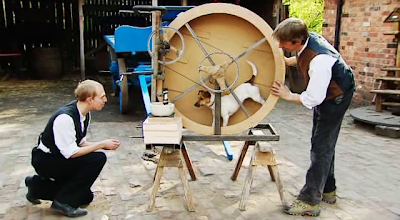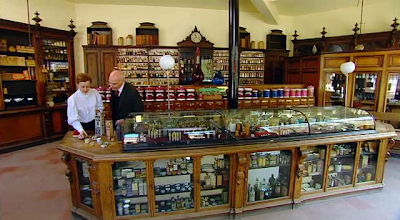Historian Ruth Goodman of Victorian Farm fame is back, this time with Professor Nick Barber and PhD student Tom Quick. Together they recreate a Victorian Pharmacy in Blists Hill Victorian Town in Shropshire county, England. The series is made of four 60 minute episodes, and shows the 60 year evolution of the Victorian Pharmacy.
This evolution is so interesting I'll give a quick summary: In the early Victorian Era pharmacies were a novel idea, and anybody could trade as a pharmacist. Most cures were based on old beliefs and remedies. Addictive substances such as opium and cannabis were used in cures. Toxic
metals such as arsenic, lead, and mercury were also used. Addictions, overdoses, and poisonings were common. Blood letting and purging were still practised.
In the 1850's the Victorians thought all diseases were caused by an invisible gas called miasma which was present in bad odours. Pharmacists sold cure-alls to cure or prevent these diseases. In the 1860's scientists discovered the existence of germs. This lead to the creation and sale of antisceptics and disinfectants.
 |
| Bloodletting: leeches and scarifier |
It was only with the introduction of The Pharmacy Act 1868 that pharmacists were required to hold a professional qualification. By the end of the 19th century pharmacists started stocking branded products, as opposed manufacturing everything themselves.
 |
| Victorian hydrotherapy and electrotherapy |
The pharmacy shown in the series is very interesting visually. It's full of bottles with coloured liquids, drawers full of herbs, test tubes, and beakers. Several times throughout the episodes the team extract chemicals from raw materials, such as carbolic acid from coal tar or salicylic acid from willow bark. Pharmacies were a hotbed of experimentation, and many products used to this day were invented by pharmacists.
The pharmacies' aim was always to make money, and there was a heavy emphasis on marketing. They created different versions of cures for the rich and poor, for example pills could be coated in silver leaf for the rich. Some of the marketing efforts shown in the series include a grand opening with a brass band playing outside, putting up posters, creating a dog powered pestle and mortar as a publicity stunt, and having a fireworks display.
 |
| Dog powered pestle and mortar |
Pharmacies also exploited any niche they could make money out of, for example the production of exotic foods requiring precision, such as sauces, and making veterinary cures. Throughout the decades they added more and more products, such as medical corsets, photographic equipment, perfumes, skin care products, and dentistry services.
Final Verdict ★★★★★
The Victorian Pharmacy series is very sombre in tone compared to Victorian Farm, as it deals with medical history and diseases, but the evolution of pharmacies is extremely facinating. I give it a big thumbs up!




No comments:
Post a Comment